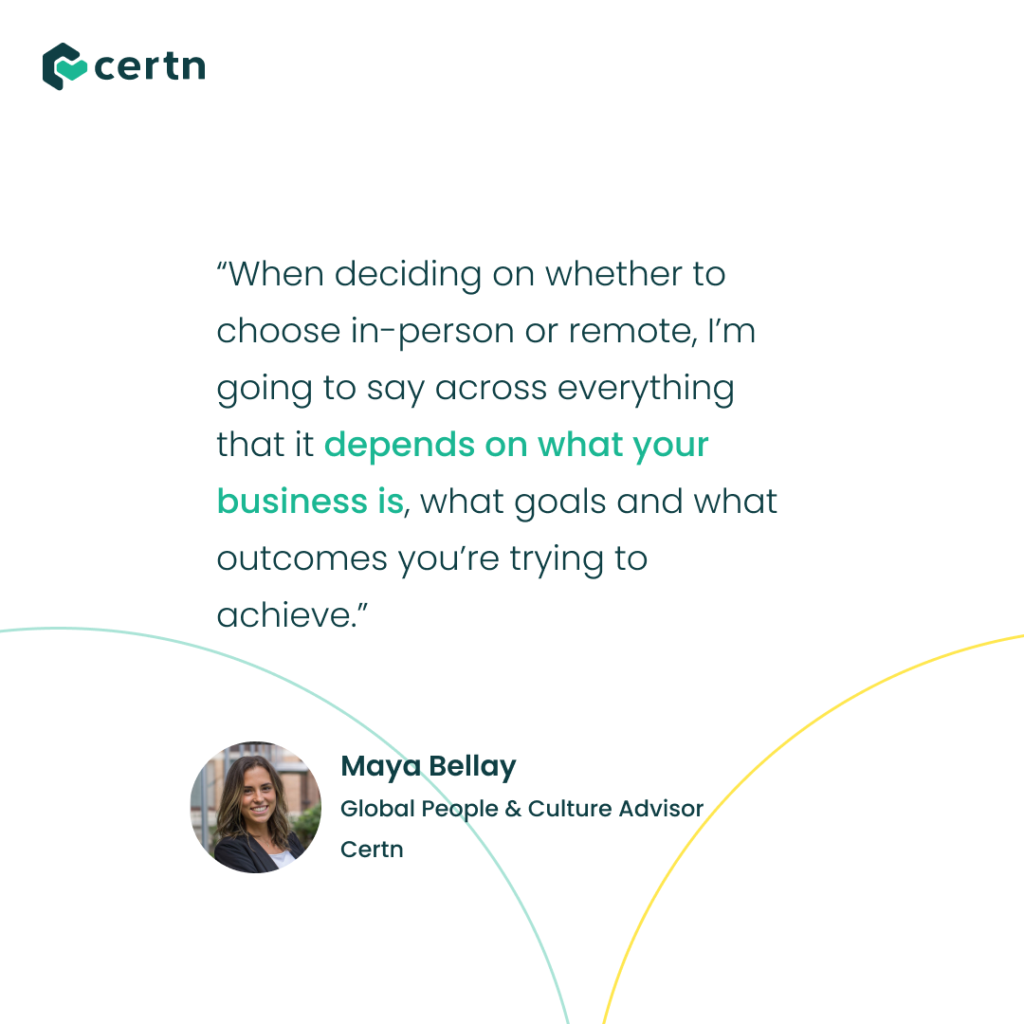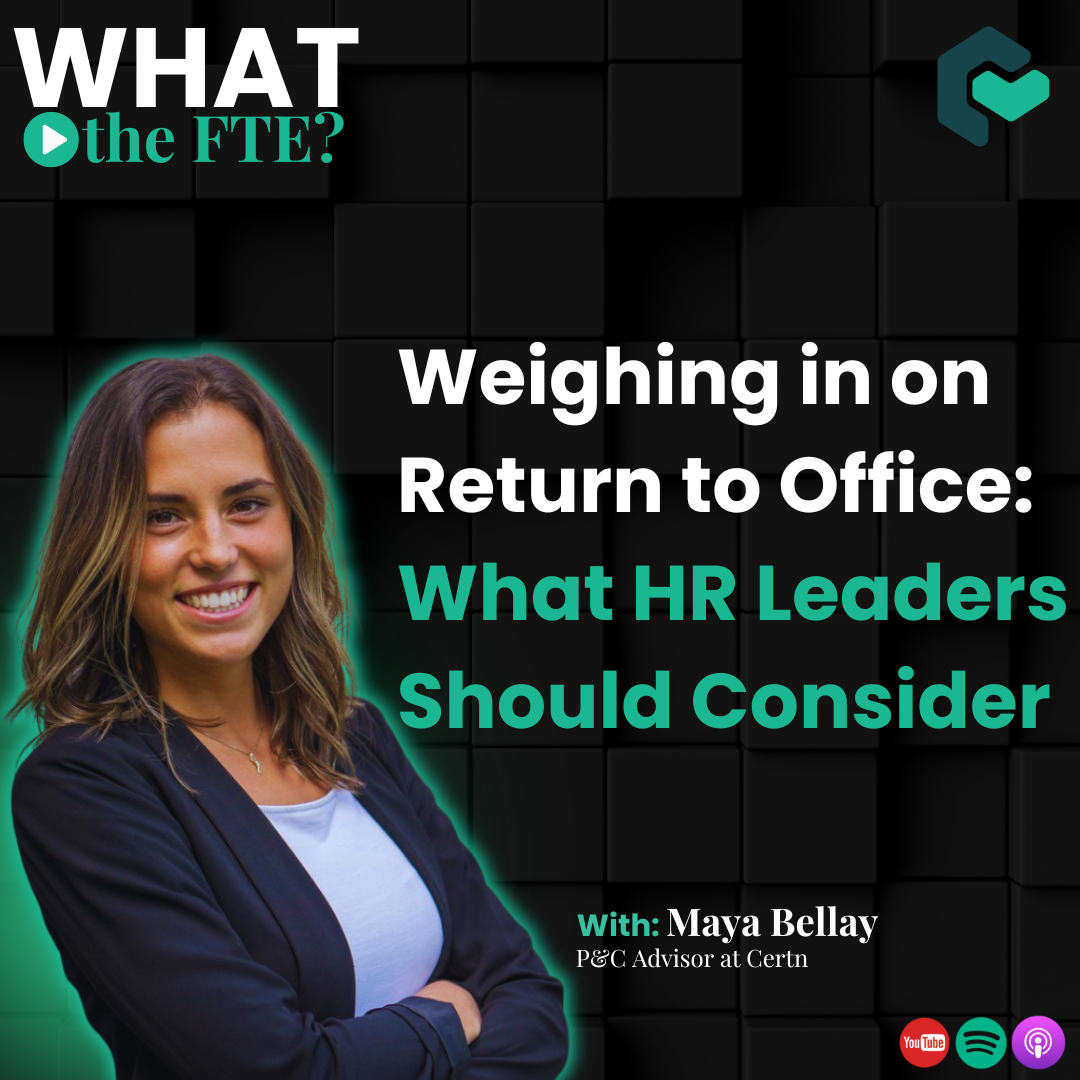What the FTE? is a podcast by Certn where we explore the tough questions surrounding the future of work, risk management, and employee experience. Whether you’re an HR leader, a TA newbie, or simply curious about the changing nature of work, this podcast provides you with practical insights to help you secure your seat at the table.
This week Certn’s CEO, Andrew McLeod, interviews Maya Bellay, Global People and Culture Advisor. Maya has navigated everything from recruitment and onboarding to offboarding at Certn for over five years, tackling it all with a human-centred and collaborative mindset.
—
As HR leaders, you’re leading the charge in shaping the future of work amid evolving workplace dynamics, one of which is the return to office (RTO) debate.
Amazon CEO Andy Jassy pushed the topic of RTO mandates back into prominence in September 2024, pressing the company’s workers to get back to their offices five days a week. Elon Musk, CEO of Tesla and SpaceX, in his special advisory role to the US government, raised the potential of requiring the entire US federal workforce to work in-office full-time in January 2025. Though, more recently, Jamie Dimon, CEO of JPMorgan Chase, took a firm stance stating that he doesn’t care (to put it politely) about a 1,200-signature petition opposing the RTO mandate to take effect this month.
As these corporate giants battle the complexities of RTO, LinkedIn has been buzzing with diverse opinions from HR leaders and job seekers alike, all weighing in on what the future of office work should look like. At Certn, we see firsthand how hiring trends shape workplace policies, and have taken a people-first approach.
Though, to get a clearer picture on the topic, I interviewed Maya Bellay, Global People and Culture Advisor. Maya has navigated everything from recruitment and onboarding to offboarding at Certn for over five years, tackling it all with a human-centred and collaborative mindset. Maya’s holistic approach to people strategy makes her a perfect person to weigh in on RTO.
Return to Office: Beyond the Binary
After the COVID-19 pandemic, hybrid working, a model combining in-office and remote work, gained more traction. Though, Maya points out that the remote versus in-office debate is too simplistic. The reality? A one-size-fits-all approach doesn’t work.
While figures like Jassy, Musk, and Dimon oppose hybrid models, 60% of North American leaders have embraced hybrid approaches, offering employees autonomy in deciding where they work. Zoom’s Navigating the Future of Work white paper, where the hybrid work statistic comes from, also notes 27% are in-office and 13% are remote. This definitely adds an interesting layer to the conversation!
Hybrid Work Model
Maya and the rest of Certn’s People & Culture team regularly advise me that hybrid work models not only support job satisfaction but also attract top talent. Leaders like Mark Cresswell of Scalable, an HR software, seem to agree, stressing that rigid RTO policies may risk employee disengagement. You can read his full take in theHRDIRECTOR.
If you’re looking for more statistics on the value of a hybrid work model, a Randstad Workmonitor report from January 2025, reveals that 83% of surveyed employees value work-life balance in their current or future jobs, even surpassing pay (pay is 82%). This preference seemingly reinforces the importance of maintaining hybrid models while addressing the challenges they bring.
From what I can tell, HR leaders who embrace hybrid work gain a competitive edge in talent acquisition. In their view, a flexible workplace isn’t just a perk, it’s a hiring advantage.
Aligning HR with Business Goals

In our conversation, Maya advocates for using business goals as a compass when making workplace model decisions. Sometimes, she points out, especially in rapidly growing companies, co-locating employees makes sense. As you expand globally, though, remote work may become more practical than maintaining office spaces around the world.
Maya and I discuss how flexibility, coupled with incentives such as social gatherings and team-building activities can help foster a culture of collaboration, without mandating office attendance. (I also confess a recent #RTOfail, but you have to tune into the episode to get the nitty gritty.)
I’m generally a fan of co-locating people, but I’ve landed on more flexible arrangements and “carrots” over “sticks,” incentives such as the social lunches and extracurricular sports Maya and I cover. Plus, at this point, for the size of the company and where we are, it doesn’t make sense to have everybody come in to the office.
As an aside, I personally think it’s good for founders to be in the same area. That’s my personal experience, and it seems to be with consistent with anecdotes from other founders. (Check out the popular r/ycombinator Reddit community for more founder insights, including remote cofounder challenges.)
Redefining In-Person Collaboration: Quality Over Quantity
Maya’s personal take is that the “always-on” office culture is outdated. Purposeful in-person engagements can lead to more meaningful collaboration.
More specifically, Maya emphasizes that the value of in-person interactions lies in their quality, not frequency. In hybrid or remote models, strategic face-to-face meetings, such as quarterly team retreats or project kick-offs, can strengthen relationships and drive innovation without the need for daily office presence. She thoughtfully cites Priya Parker’s The Art of Gathering as inspiration as well, implying that it offers valuable insights that can be directly applied to the return-to-office debate by emphasizing the importance of intentionality in how and why we gather.
The book argues that the success of any gathering depends on its purpose, design, and the connections it fosters. In the context of businesses transitioning back to the office, her approach encourages companies to rethink the purpose of in-person work—moving beyond outdated assumptions about office presence and instead focusing on how to make physical gatherings meaningful and engaging. By carefully crafting office experiences that prioritize collaboration, community building, and clear objectives, businesses can ensure that the return to office is not just a logistical necessity but a transformative opportunity to create more purposeful and connected work environments.
There are a few companies, like PolicyMe, that come to mind for Maya, companies that are being intentional about in-person work, asking questions such as:
- What does it mean to be together?
- What are we trying to achieve?
- How are we going to achieve our goals?
- What does work look like for our organization?
PolicyMe facilitates quarterly in-person get togethers on a team basis and twice-annual company-wide offsites, as do companies such as zLinq and Buildout. I’d be remiss not to mention Certn again. I feel like we’re really thoughtful about our IRL team meetups when they happen.
Cultivating a Culture of Trust and Autonomy
Trust is the foundation of a successful hybrid model. As our mission here at Certn attests, building trust is essential. Allowing employees to manage their own schedules empowers them, fosters accountability, and strengthens mutual respect. By embracing autonomy and creating spaces for meaningful connection, leaders can nurture an environment where people feel valued and engaged.
Redefining the Return to Office: Intentionality Over Mandates in Shaping the Future of Work
The return to office (RTO) debate is a complex and nuanced issue, but Maya’s reflections, alongside her insights from The Art of Gathering, underscore the importance of intentionality when it comes to the RTO debate. Rather than simply enforcing rigid policies, HR leaders should focus on understanding the deeper purpose behind in-person work.
What are we trying to achieve when we gather?
How can we design these moments to drive innovation, collaboration, and meaningful relationships?
The answers will not only help define the future of your office but will also help retain and attract top talent who value purposeful and flexible work environments.
The future of work isn’t about mandates, it’s about creating intentional, engaging workspaces. HR leaders have the opportunity to shape policies that drive retention, collaboration, and trust.
Let’s rethink the way we work.
Tune into the full podcast: https://certn.co/podcast/





